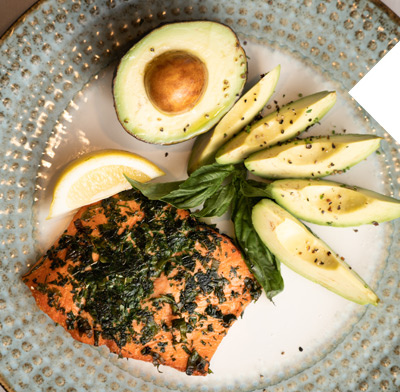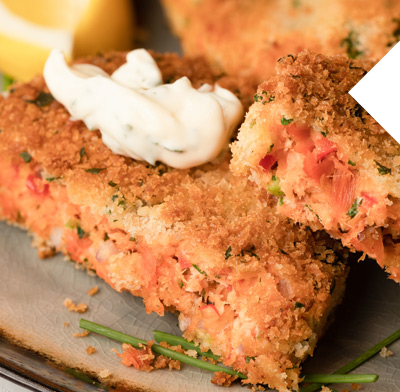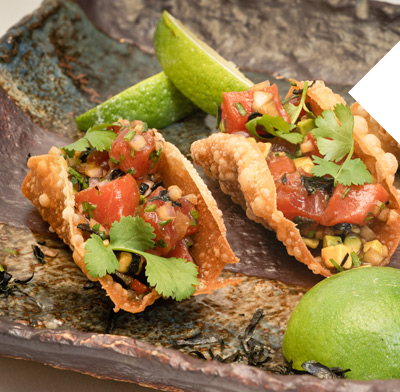After our long rainy winter, anglers from all over the Northwest look forward to the opening of blackmouth salmon fishing in in the San Juans. Blackmouth are juvenile king salmon, and unlike their older Chinook siblings, they resist the urge to head for deeper water. Instead, they like to hang out in the shallower waters of the San Juan Islands and Puget Sound. They get their name from the dark black gum line that distinguishes them from other Pacific salmon. Each year, I am proud to fish the blackmouth derbies in the San Juans and catch my fair share of these tasty winter salmon, which are excellent eating and known for their delicate mouth feel and clean finish.
There is only one way to get your hands on these delicious winter blackmouths—go fishing. If you don’t fish, maybe you know a local sports angler. Take them a freshly baked apple pie and tell them how much you love blackmouth salmon, and then maybe, just maybe, you’ll be gifted with a filet or two.
I have prepared three recipes this month that showcase the flavor of blackmouth salmon. Each of these recipes is best prepared with a specific section of the salmon filet. First is the tail, which is the thinnest section and can be less fatty and a little tough. It should be used in salmon cakes. The remaining filet can be divided into three sections, the top loin, middle loin, and belly. The top loin is the top 2” to 3” of the filet and is considered the premium cut because of its high fat to flesh ratio and is best for grilling, roasting, poaching, and sautéing.
The middle loin has a higher fat to flesh ratio and a delicate mouth feel. It is ideal for sushi and poke. Last is the belly, which has the highest concentration of Omega-3s and is a true delicacy. I like to season the belly with a pinch of sea salt, then pan-sear over high heat for a few seconds on each side, and then serve with a cold, crisp glass of sauvignon blanc. The delicate natural flavors of the young salmon basted with its own succulent oils make blackmouth some of the finest salmon you will ever eat.
 |
Basil Crusted Blackmouth SalmonMy grandfather was a commercial fisherman, I have processed salmon on the Yukon River and have served salmon every day in my restaurants for 40 years, but I always look forward eating fresh salmon. Sadly, most salmon served in restaurants is overcooked. You know that your salmon is perfectly cooked when clear salmon nectar streams from the filet as you cut into your first bite. This experience is practically impossible in even the finest restaurants due the delicate nature of the fish and the time it takes to deliver to the table. For the home cook, all you need is a 220˚ probe thermometer and well-timed side dishes to create a perfectly cooked salmon experience. Before starting to cook the salmon, set the table, prepare the sides dishes, pour the wine, and have everything ready waiting for the main event to arrive straight from the sauté pan. While preparing the salmon, insert the pointed end of the thermometer into the center of the salmon and when the temperature reads 122 -125˚ moving toward 130˚, this is the time to quickly remove the filets and rush them to the dinner table. Without hesitation, invite your guests to cut into the salmon and savor their first bite by inhaling the salmon aroma, then slowly rolling the juices over the middle of the tongue.
|
Directions: Rub olive oil over the entire surface of each filet. Season with sea salt.
In a small bowl combine basil and parsley. Sprinkle the herb mixture over the entire surface of each seasoned salmon filet. Using your hands, press the herbs into the filet by applying light pressure.
In a 10-inch skillet over medium heat, add the olive oil and butter. When hot, gently lay the salmon filets in the skillet in a single layer. As outside edges of salmon begin to brown, turn the filet over, about 2 to 3 minutes. Continue cooking the filet until the internal temperature of the salmon in 125˚ using a probe-type thermometer.
Quickly transfer the pan-fried salmon to a warm serving platter and squeeze a small amount of fresh lemon juice over the top of each filet. Serve immediately.
 |
Fresh Salmon CakesMakes 6 entrée size cakes
Breading:
|
Directions: Combine all ingredients (except for the breading ingredients) in a medium bowl and mix well.
Create a breading station using three bowls. In one, combine breadcrumbs and parsley. In another, place the whipped eggs. And in the last bowl, combine the flour, salt and pepper.
For appetizers, measure ½ ounce of fish cake mixture and form into a tight ball with the palm of your hands. If preparing as an entrée, measure 3 ounces of mixture. Once all the fish mixture has been rolled into balls, roll in seasoned flour, followed by dipping in whipped eggs, and lastly, roll the balls into the breadcrumbs and parsley.
Coat fish cakes in bread crumbs and form into a “hockey puck” shape in the palm of your hand, using your thumb to form a vertical edge. Place complete crab cakes on baking sheet, wrap and store in refrigerator until ready to cook.
Place a large skillet over medium heat with vegetable oil about a ½-inch deep. When oil reaches 300 degrees, drop fish cakes into skillet cook for about 1-2 minutes on each side or until golden. Place cooked salmon cakes on a plate lined with a paper towel, and then transfer them to a serving dish when ready to present. Serve with tartar sauce and fresh lemon.
Tartar Sauce with Capers and Artichoke Hearts
- ½ cup refrigerator dill pickles, rough chopped and drained
- ½ cup yellow onion, rough chopped
- 4 each green olive with pimento
- 1 tablespoon capers, drained and rinsed
- ¼ cup artichoke hearts, drained, rough chopped
- 1 tablespoon Italian flat leaf parsley, finely chopped
- 1-1/4 cup mayonnaise, Best Foods
- 1 tablespoon fresh lemon juice
- Pinch kosher salt
- Pinch white pepper, ground
Directions: Assemble food processor with metal blade. Add pickles, onion, green olives, capers, and artichoke hearts in processor bowl. Using the on-off pulse to finely chop, about 8 pulses should net 1/16” to 1/8” pieces. In a medium bowl, combine mayonnaise, parsley, lemon juice, salt and white pepper. Add finely chopped pickled ingredients and mix well to combine. Refrigerate for at least 12 hours before serving to develop flavors.
 |
Blackmouth Salmon Poke TacosServes 6
|
Directions: Combine all ingredients into a non-reactive bowl (I like to use a glass bowl). Gently toss the ingredients together and coat well. Cover with food film and store refrigerated for 1 to 2 hours.
Heat 2 cups of vegetable oil in a 2-quart saucepan to 350˚ F. Fry each won ton wrapper, one sheet at a time, until light brown and crisp, about 30 seconds. To make a taco shell shape, trim a 2-inch wooden dowel into lengths of 4”. Wrap the won ton wrapper around the dowel. Using tongs, hold the won ton-wrapped dowel and submerge in the hot oil until the desired shape begin to hold.
Remove the dowel from the oil and allow the won ton taco shell to continue to crisp. Place crispy shell on paper towel lined plate and allow to cool. Fill each shell with cold salmon poke and top with micro greens. To hold the poke tacos upright, place a lime wedge between each taco.